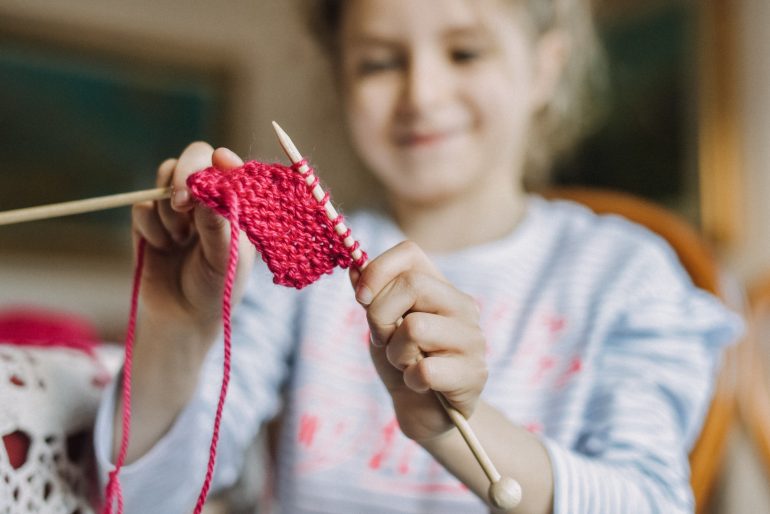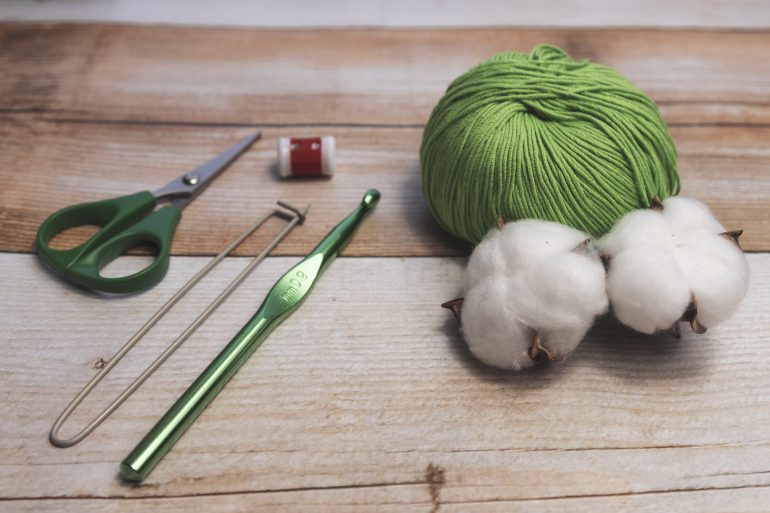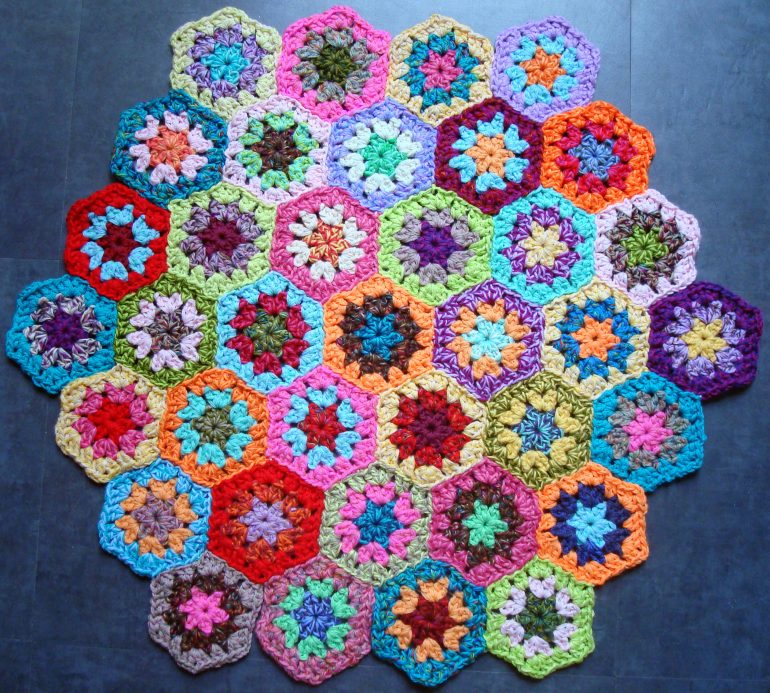If you’ve ever held a crochet hook and felt a twinge of uncertainty or admired a handcrafted blanket and thought, “Could I create something like that?”, this article is for you.
This guide to easy crochet for beginners aims to demystify the basics of this beloved craft, offering a gentle introduction for those eager to learn and create. Whether your goal is to make a cosy scarf for a loved one, a decorative centrepiece for your home, or simply to experience the meditative joy of crafting stitch by stitch, this guide is your starting point.
What is Crochet?

A little girl crocheting. (Credit: Stefania Pelfini, La Waziya Photography via Getty Images)
In its simplest form, crochet is a type of needlecraft that uses a hook to interlock loops of yarn or thread.
The origins of crochet may be as early as the mid-sixteenth century at the court of Mary Queen of Scots, where her tailor is said to have supplied her with a fine silk thread for sewing and crochet, or ‘soye à coudre et crochetz.’ Whether she managed to learn to crochet has been lost to history, but if we fast-forward a few hundred years, the first published instructions for crochet appeared in a Dutch magazine in 1823.
In the UK it was often known as ‘shepherd’s knitting’, and from the 1840s onwards, crochet became a popular handicraft.
Today, if you want to learn how to crochet, we’ll give you the basic tips you need to start a new and exciting hobby!
Crocheting for Beginners - What You Need To Get Started

Crochet tools (Credit: Rosa María Fernández Rz via Getty Images)
From a crochet scarf for beginners to a stunningly beautiful but incredibly complex Casa Kahlo blanket, the art of crochet is all about confidence, and the best bit is that to start, you just need two things – a crochet hook and some yarn.
There’s many different types and thicknesses of yarn, and the same goes for hooks, but for easy crochet for beginners, we’d suggest a medium weight yarn (often known as worsted weight) and a 4.5mm – 5mm hook.
When you decide you want to learn to crochet, you want to make it as straightforward as possible, and a medium-weight wool and a medium-sized hook are ideal for beginners for a number of reasons –
Visibility of Stitches
Medium weight yarn is thick enough to allow you to clearly see and understand each stitch you’re making, which is essential when learning.
Forgiveness
The yarn is neither too thick (which can feel unwieldy) nor too thin (which can be fiddly). Mistakes are easier to spot and correct.
Versatility
The vast majority of beginner-friendly patterns use medium weight yarn. This gives you a wide variety of exciting projects to choose from.
Comfort
A 4.5mm to 5mm hook is comfortable for most hands. It’s not so small that it’s hard to manipulate, nor so large that it feels unwieldy.
Availability
Medium weight yarn is one of the most widely available yarn weights in craft and hobby shops, and there’s a vast range of colours to choose from.
As crocheting for beginners becomes crocheting for intermediates, you’ll naturally develop preferences for certain hook sizes and yarn weights. But medium yarn and a medium hook is a great starting point.
Learning to Crochet - The Basic Techniques

Crochet close-up (Credit: LukaTDB via Getty Images)
If you want to learn how to crochet, first you must learn how to hold the hook and the yarn and then you need to learn to tie a slip knot.
Holding the Hook
There are two common ways to hold the hook – the pencil grip and the knife grip. They’re relatively self-explanatory so try both to see which one feels the most comfortable. Indeed over time you may develop your own method for holding the hook.
Holding the Yarn
Again, there are two main ways to hold the yarn, and both assume you’re right-handed. If you’re left-handed, simply reverse the instructions.
Method 1
Lay the yarn over your left hand in such a way that it passes over your little finger, under your ring and middle fingers, and over your index finger. This method allows you to use your little finger to adjust the tension by simply moving it closer to, or farther away from, your hand.
Method 2
Lay the yarn over your left hand, passing under your little and ring fingers, over your middle finger, and then under your index finger. With this method, the tension is adjusted by moving your index finger up and down.
Tying A Slip Knot
This is a straightforward way of tying a slip knot. One of the most important things to learn when you start to learn how to crochet.
Make a Loop
Hold the yarn end in your left hand and drape the yarn down the back of your hand. Bring it across the front of your hand, crossing over the yarn tail, to form a loop.
Insert Your Fingers
With your right hand, insert your index and middle fingers into the loop from underneath.
Grab The Yarn & Pull Through
With those two fingers, grab the yarn that’s leading to the yarn ball (not the short tail end). While holding onto the yarn tail with your left hand, pull up a loop with your right hand’s fingers.
Make it Tight
Remove your fingers and pull on the yarn tail to tighten the knot slightly. You should now have a loop. This is your slip knot.
Insert the Hook
Put your crochet hook into the loop and pull both ends of the yarn to adjust the size of the loop around the hook. It should be snug but not too tight.
Be Comfortable
Easy crochet for beginners should be enjoyable, so here are a few useful tips and techniques.
Stay Relaxed
If your hand feels tense or you feel like you’re gripping the yarn too tightly, your stitches can end up too tight which may make it harder to insert your hook into them on subsequent rows. The yarn should glide smoothly.
Adjust as Required
Everyone’s hands are different so feel free to adjust the way you’re holding the yarn to find the most comfortable position.
Practice, Practice, Practice
As you learn to crochet, holding the yarn will become a natural process. Over time, you’ll find the perfect tension and grip that works best for you.
Now you’re ready to start, and what better place to start your journey than with a crochet scarf for beginners! As with many aspects of crocheting, the more you practise, the more intuitive and effortless it becomes.
The Chain Stitch

A woman crochets a chain-stitch. (Credit: Jupiterimages via Getty Images)
The chain stitch in crochet is a foundational technique essential for beginners who want to learn to crochet. It’s the most straightforward stitch you’ll encounter and is the starting point for the majority of crochet patterns. Typically, patterns commence with a specific count of these chain stitches. After you’ve made your slip knot and you’ve settled on a comfortable way to hold the hook and yarn, you’re ready to start crocheting!
Step 1
This is known as Yarn Over (which you’ll see abbreviated as YO in crochet patterns). With the hook, scoop or ‘catch’ the yarn.
Step 2
Use the hook to pull the yarn through the loop that’s already on the hook.
Congratulations, you’ve just made a chain stitch! Now repeat the process as many times as you like when you’re practising, or as the pattern dictates. As you progress, you’ll see a series of V-shapes forming. These are your chains. The front of the chain looks like a series of Vs, while the back has a ‘bump’ or a ‘ridge.’
The Adventure Begins…

Crochet hexagons (Credit: eclectic gipsyland bohemian and colorful crochet via Getty Images)
Learning to crochet for beginners is like opening a door to a world of creativity, mindfulness, and endless possibilities. The chain stitch, in its unassuming simplicity, lays the foundation for this expansive universe of patterns and designs. As you master this initial step, remember that every crochet masterpiece begins with a single stitch. Embrace the learning process and relish in each new skill you learn. With patience and practice, the intricacies and nuances of crochet will become second nature, and you’ll soon find yourself weaving stories and memories, one loop at a time.












